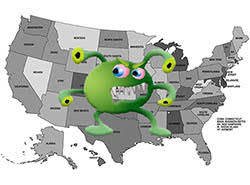New Hampshire, Colorado and Virginia Top the List of States with Highest Malware Rates So Far in 2017
 Computer users in New Hampshire were three times as likely to get a malware infection on their computers compared to the rest of the country. That's according to data released today by Enigma Software Group (ESG), makers of the SpyHunter anti-malware program.
Computer users in New Hampshire were three times as likely to get a malware infection on their computers compared to the rest of the country. That's according to data released today by Enigma Software Group (ESG), makers of the SpyHunter anti-malware program.
The ESG research team compiled their latest data based on more than 1.5 million infections detected on SpyHunter in all 50 states in the first six months of 2017. Surprisingly to some, it turns out that the infection rate in New Hampshire was 201% higher than the average infection rate for all 50 states. Colorado, Virginia, New Jersey, and Oregon were the next highest states.
"It's hard to tell exactly why some states have higher infection rates than others," said ESG spokesperson Ryan Gerding. "In the top five alone, you've got east coast and west coast states, highly populated states and sparsely populated ones. Regardless of where you live, it's always important to stay vigilant for infections all the time."
Infections can come in many forms. Some may be adware, which forces massive amounts of popup advertising to appear on your computer. Some may be rogue anti-spyware programs, which look like legitimate programs that promise to remove infections, but in reality are just taking your money without doing anything. Many people have seen headlines about ransomware, which can lock important files and hold them hostage unless a ransom is paid. However, the vast majority of files detected can be considered nuisance-ware. Those are potentially unwanted programs that change browser settings, switch your default search engine, install unwanted toolbars, and slow down performance.
Other key findings from the ESG's mid-year infection analysis include:
- Overall infections have actually dropped on a monthly basis since January 2017. In June 2017, infections in the US were down 31% over infections in January. The experts at ESG believe that's due in part to users updating to more secure versions of their Windows operating system.
- On a city by city basis, Orlando, Denver, and St. Louis had the highest infection rates compared to other major cities in the U.S.
- Tennessee, Alabama, and Mississippi had the lowest infection rates in the first half of 2017.
ESG offers the following tips to keep computers protected from all kinds of malware.
- Regularly backup your data. Ideally, you would use a physical back up (external hard drive connected to your computer) and a cloud backup. By backing up your hard drive, what whatever happens to your computer, you know your data is safe.
- Install a trusted malware removal software like SpyHunter, and set it to perform scans and updates automatically.
- Set your operating system to update automatically and regularly. It's tempting to click the button to 'update later' when a notification pops up. Still, it's always better to update your software as soon as possible.
- Think about that link. Be very wary of links sent to you in emails and social media messages. Crooks are getting much better at creating bogus messages that look like something legitimate (messages from friends, emails from retailers), but, actually, have malicious intent.
Below is the full ranking of all 50 states and how much their infection rate differed from the national average in the first six months of 2017.
- New Hampshire 201% higher than the national average
- Colorado 143% higher than the national average
- Virginia 80% higher than the national average
- New Jersey 64% higher
- Oregon 25% higher
- New York 24% higher
- Montana 24% higher
- Missouri 23% higher
- Arizona 18% higher
- Maine 17% higher
- Wyoming 17% higher
- Arkansas 17% higher
- Wisconsin 14% higher
- Massachusetts 11% higher
- Georgia 10% higher
- North Dakota 8% higher
- Nevada 6% higher
- Nebraska 5% higher
- Rhode Island 5% higher
- Florida 3% higher
- South Dakota 3% higher
- Vermont 2% higher
- Washington 1% lower than the national average
- Iowa 1% lower than the national average
- Kansas 2% lower
- Ohio 3% lower
- Idaho 3% lower
- Pennsylvania 5% lower
- South Carolina 5% lower
- Illinois 6% lower
- Maryland 6% lower
- New Mexico 7% lower
- Texas 9% lower
- North Carolina 10% lower
- Alaska 10% lower
- Utah 16% lower
- Michigan 18% lower
- Kentucky 20% lower
- Louisiana 20% lower
- Oklahoma 21% lower
- West Virginia 24% lower
- Minnesota 27% lower
- Hawaii 30% lower
- California 30% lower
- Connecticut 31% lower
- Delaware 32% lower
- Indiana 35% lower
- Tennessee 47% lower
- Alabama 50% lower
- Mississippi 53% lower
|
|
|